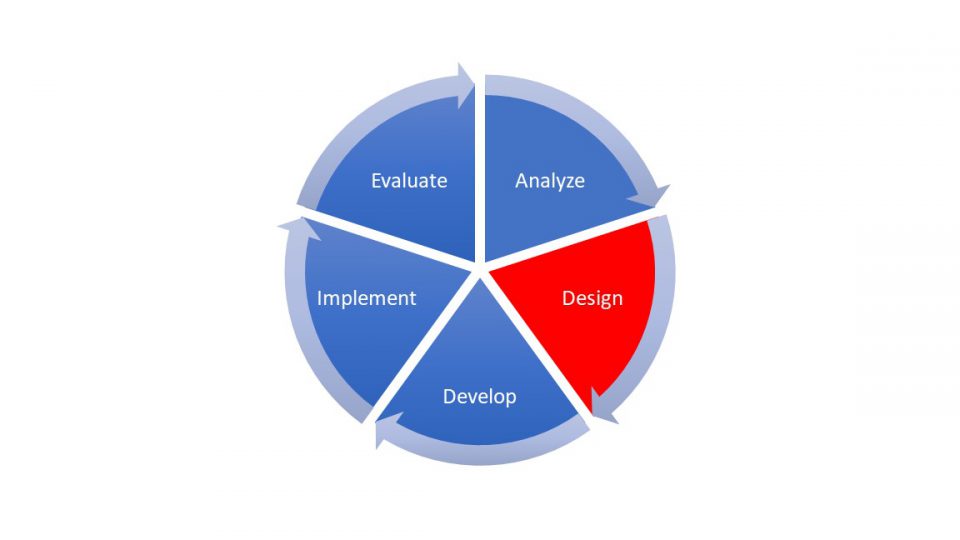D – Design
Our previous post focused on how the Analyze phase of training content development applies to journalism and how Microsoft 365 tools can support that process. This article focuses on the Design phase.
We introduced the ADDIE model here.
The five phases of content development are:
D – Design
In learning and development, when we get to the Design phase, we know the project goals and the audience. Now, we build out the training framework.
This stage is when we evaluate the steps to achieve the Learning Objective — the training goal – and answer some key questions, such as:
- Will we host a webinar?
- Will it be a classroom training session?
- Might we accomplish our goal with self-paced video training?
- What sort of follow-up do we want to do?
The Design phase is when the big decisions are made: We’ll put together an outline of content, exercises we have (or need to build), and demos we want to do. Essentially, we create the overall training structure.

My three primary tools for this process are OneNote, Excel, and Teams. For some bigger projects, I’ll use Planner and Word. Here are some tasks and the tools I leverage to complete them.
- Drafting the flow: OneNote is where I build from the Analyze phase. I’ll draft out different learning objectives. I’ll draft outlines of the training flow. I’ll create to-do lists for additional resources. I’ll save files (Excel, PowerPoint, Word) and my links (web pages, other documents) to a single OneNote.
- Managing lists: I rely on Excel for tracking lists that may involve number-crunching or simply complex project details. It’s a powerful tool for calculating dates and tracking status of sub-projects. Lately, for lists that don’t involve as much math, I’ve been using the new Microsoft Lists tool.
- File storage: Teams remains the hub for storing my material. The OneNote notebook can be attached to a Teams channel or multiple channels. I create folders within each channel and load up spreadsheets, outlines, photos, video samples, and more. Teams also can accommodate third-party apps.
- Defining success: I want this to be a successful training. But what does that mean? Is success determined by views or knowledge retention? By business impact or personal satisfaction? OneNote and Teams are important tools here, too, because they facilitate the conversation with other stakeholders. If my definition of success is different from my boss’s or my client’s definition of success, then we will likely have a problem. Using our collaboration tools helps us all reach a collective understanding of the key metrics so we can build the training to meet that goal.
By the end of this Design phase, I’ve locked the core elements of the content and the plan.

For reporters, this is like the early drafting phase. They’ve amassed a lot of information through their interviews and research and can start planning the story. They work through the visual and multimedia support they’ll need, where different elements of the report will sit in the narrative, and be able to do a planning review. Those same bullets and tools apply.
- Drafting the Flow: OneNote remain a valuable tool for building on the early work in the analyze phase. It gives you an easy place to work on different story ideas and frameworks. For breaking news, that could mean taking some pieces and dragging them around the page to quickly craft a narrative. For investigational or feature stories, it may mean working through pages of notes, photos, and document in that notebook to tell the story. And if it’s shared, colleagues working on different angles to the story can all share the same outlines to better define the edges between stories.
- Managing lists: That raw data collected throughout reporting has to be processed somewhere, and often that means Excel. Here is where you can start looking at the numbers and design a repot that tells the story of that data. Knowing what the facts tell you is important if you’re going to tell the facts.
- File storage: Teams is the place to store your files, photos, and early drafts whether you are working solo or working as part of a broader reporting team.
- Defining success: What does successfully reporting on this story mean? Are there key metrics you need to hit like circulation or number of comments? Is it time spent on the web page? Teams is a great environment to work through that with your colleagues. The communication platform means everyone can see how you are defining success to reduce surprises. In a multi-person reporting team this can help.
By this point, the hard work is done. You know what resources you have. You know what resources you need to get. You may come out of this phase ready to write and record, or you may know what other work you need to do in the next phase like:
- Conduct interviews with key sources
- Track down an expert
- Shoot video
- Create animations
- Photograph objects or people for the story
- Build a social infrastructure for keeping the story alive
For a complex story, each of these elements could spawn its own ADDIE analysis since ultimately, we’re talking a framework for creating content.
Now, we just have to turn those outlines and plans into a story. It’s time to move to the Develop phase, to be discussed in the next element.
Continue to ADDIE Basics for Journalists: A Framework for Crafting Stories — Develop (Part 4)




